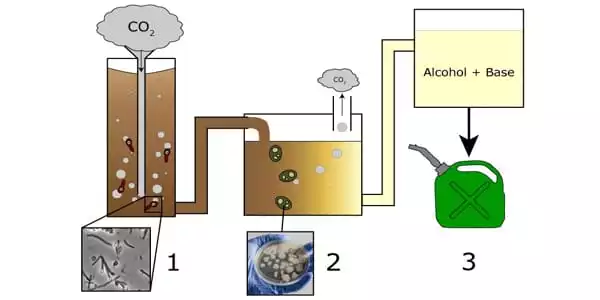Biofuels are derived from living organisms or the waste they generate. Plants are used to produce ethanol, one of the most common biofuels. The plant material used is the edible part of the plant, such as sugar cane, sugar beets, or corn kernels, because they can be easily broken down to sugar (glucose). Microbes such as the yeast Saccharomyces cerevisiae can then ferment (break down) the sugar to produce ethanol.
A team of biologists and engineers engineered a microbe to produce biofuel using only three renewable and abundant source ingredients: carbon dioxide, solar panel-generated electricity, and light. The resulting biofuel, n-butanol, is a truly carbon-neutral fuel substitute that can be blended with diesel or gasoline. Washington University in St. Louis researchers have discovered a new way to train microbes to produce a readily usable biofuel.
A team of biologists and engineers engineered a microbe called Rhodopseudomonas palustris TIE-1 (TIE-1) to produce biofuel using only three renewable and abundant source ingredients: carbon dioxide, solar panel-generated electricity, and light. The resulting biofuel, n-butanol, is a truly carbon-neutral fuel substitute that can be blended with diesel or gasoline. The findings were published in the journal Communications Biology.
Microorganisms have evolved a bewildering array of techniques to obtain nutrients from their surroundings. We used the power of microbes to convert carbon dioxide into value-added multi-carbon compounds in the form of a usable biofuel.
Arpita Bose
Arpita Bose, associate professor of biology in Arts & Sciences, led the study, which was co-authored by members of her laboratory and engineers from Washington University’s McKelvey School of Engineering.
“Microorganisms have evolved a bewildering array of techniques to obtain nutrients from their surroundings,” said Bose. “One of the most intriguing of these feeding methods is microbial electrosynthesis (MES). We used the power of microbes to convert carbon dioxide into value-added multi-carbon compounds in the form of a usable biofuel.”
Wei Bai, a PhD graduate of McKelvey Engineering’s Department of Energy, Environmental, and Chemical Engineering, is the study’s first author. From 2015 to 2020, Bai worked as a research assistant in the Bose lab at Arts & Sciences. Bai is now a scientist at Amyris, a company that creates sustainable ingredients using synthetic biology.

“N-butanol, the fuel we created, has a high energy content and a low tendency to vaporize or dissolve in water without combustion,” Bai explained. “This is especially true when compared to ethanol, a widely used biofuel.”
Microbes that feed via microbial electrosynthesis attach directly to a negatively charged cathode inside the MES reactor to “eat” electricity. Previous research from the Bose lab shed light on how microbes like TIE-1 use electrons to fix carbon dioxide and how they can be used to make sustainable bioplastics.
As scientists learn more about these microbes, their potential applications become more promising, according to Bose, though she acknowledges that improvements are needed before the techniques can be used on a large scale.
Producing a sustainable biofuel
Previously, other researchers investigated the use of microbes such as cyanobacteria to produce sustainable biofuels. However, because many of the enzymes involved in the biosynthetic pathways are oxygen-sensitive, these organisms produce oxygen during photosynthesis, limiting their efficiency for biofuel synthesis.
Bai and Bose created a mutant form of the microbe that could not fix nitrogen in order to investigate how TIE-1 could be used to produce biofuel. The researchers then inserted a synthetic n-butanol biosynthesis pathway into this new mutant.
When nitrogen gas was the only source of nitrogen for the microbe they created, it was unable to grow. Instead, this version of TIE-1 focused its efforts on producing n-butanol, increasing its biofuel yield without significantly increasing its electricity consumption.
“To the best of our knowledge, this is the first attempt at biofuel production using a solar panel-powered microbial electrosynthesis platform, where carbon dioxide is directly converted to liquid fuel,” Bai said. “We hope it will serve as a springboard for future sustainable solar fuel production.”
“Industrial-scale manufacturing of bioplastics and biofuels using microbial electrosynthesis can be accomplished using electricity generated by solar panels, resulting in a fully sustainable cycle,” Bose said.
“The United States and the European Union recognize microbial electrosynthesis as a critical technology for addressing sustainability and climate change,” said Bose. “Ultimately, we hope that by utilizing a microbial metabolism that evolved in the distant past, new methods will emerge to help address some of our time’s most pressing problems.”















